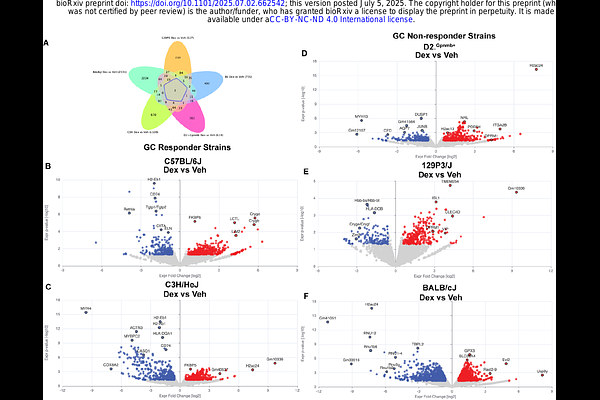Mechanistic insights into glucocorticoid-induced ocular hypertension using differences in mouse strain responsiveness

Mechanistic insights into glucocorticoid-induced ocular hypertension using differences in mouse strain responsiveness
Patel, P. D.; Patel, G. C.; Millar, J. C.; Feris, S.; Curry, S.; Geisert, E. E.; Clark, A. F.
AbstractGlucocorticoids (GCs) are widely prescribed anti-inflammatory agents. Unfortunately, many people experience negative side-effects associated with long term GC therapy, developing GC-induced ocular hypertension (GC-OHT), which can lead to secondary glaucoma. Approximately, 40% of the treated individuals are susceptible to GC-OHT. Seventy years since this discovery, the molecular mechanisms underlying GC-OHT remain unclear. We previously developed a mouse model of GC-OHT delivering the potent GC dexamethasone (DEX) and observed strain-specific disparities in the development of GC-OHT. We now compare phenotypic and transcriptomic differences between five genetically distinct inbred mouse strains to identify biomarkers of GC susceptibility, and to better understand the molecular mechanisms of GC-OHT. Like humans, mouse strains differ in their ability to develop GC-OHT. Phenotypic characterization revealed that C57BL/6J and C3H/HeJ mice are GC responders and more susceptible to develop GC-OHT. DEX treatment in these strains led to elevated IOP compared to the GC non-responder strains DBA/2J.Gpnmb+, 129P3/J, and BALB/cJ. Transcriptomic analysis of responder and non-responder mouse strains revealed novel trabecular meshwork (TM) biomarkers of GC-OHT susceptibility involving enrichment of molecular pathways unique to this response. Our study identifies putative mechanisms underlying GC-OHT and provides insight into the pathogenesis of the clinically similar but more prevalent primary open-angle glaucoma.